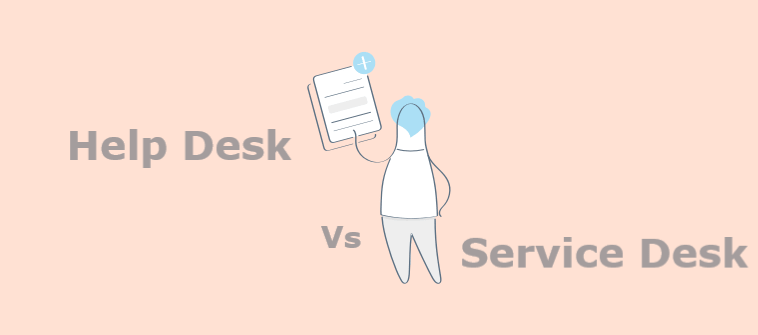Information Technology Infrastructure Library—a comprehensive framework that has become the global standard for ITSM, is transforming the way businesses interact with technology.
But what is ITIL, and why has it garnered such widespread acclaim?
This guide will help you understand the origins, principles, and structure of ITIL, exploring how it can transform IT service management within organizations to achieve greater efficiency, predictability, and alignment with business objectives.
Whether you’re an IT professional looking to refine your practices or a business leader seeking to understand the benefits of ITIL, you’ll get the insights you need to understand how ITIL can be implemented to foster business growth and technological innovation.
What Is ITIL (Information Technology Infrastructure Library)?
The Information Technology Infrastructure Library (ITIL) is a set of best practices for IT service management (ITSM) that aims to align IT services with business needs.
Initially developed by the UK Government’s Central Computer and Telecommunications Agency (CCTA) during the 1980s, ITIL has become the most widely accepted approach to ITSM. It provides a comprehensive framework for managing IT services, offering guidance on service design, strategy, transition, operation, and continual service improvement.
ITIL is designed to help organizations manage risk, strengthen customer relations, establish cost-effective practices, and build a stable IT environment for growth, scale, and change.
To put ITIL into practice, most organizations invest in an IT service management tool like IT help desk software. This tool can track incidents and service requests, automate IT support, and boost customer satisfaction.
What Is the ITIL Process Framework?
The IT Infrastructure Library (ITIL) is a set of detailed practices for IT service management (ITSM) that focuses on aligning IT services with the needs of business. It’s designed to ensure that an organization’s IT supports its core processes and facilitates growth.
The ITIL framework has evolved, being updated and refined through various versions: ITIL v1, ITIL v2, ITIL v3, and later ITIL 4. Here’s a brief overview of each mentioned version:
ITIL v1
Introduction: Launched in the late 1980s.
Structure: Consisted of a series of books that described practices for managing IT infrastructure, development, and operations.
Focus: The initial version was more technical and focused on IT operations rather than broader service management strategies.
ITIL v2
Launch: Released in 2000.
Structure: Consolidated the original volumes into a more manageable set of 7 core books, later streamlined to 9. The focus was primarily on Service Support and Service Delivery.
Focus: This version introduced the concept of Service Management as a practice, emphasizing processes and roles. It became highly popular for its structured approach to IT service delivery and support.
ITIL v3
Launch: Introduced in 2007 and updated in 2011.
Structure: Expanded the framework to 5 core volumes: Service Strategy, Service Design, Service Transition, Service Operation, and Continual Service Improvement.
Focus: ITIL v3 brought a lifecycle approach to service management, emphasizing aligning IT services with business needs and strategic objectives. It introduced the concept of the Service Lifecycle, integrating processes within a framework of continuous improvement.
ITIL v4
Launch: Released in February 2019.
Structure: ITIL v4 is designed to integrate with modern agile, DevOps, and digital transformation practices. It introduces the ITIL Service Value System (SVS), which includes the ITIL Service Value Chain, a set of key practices, and the four dimensions model.
Focus: The focus of ITIL v4 is on adapting IT service management practices to the fast-paced and complex digital environment. It emphasizes the co-creation of value through collaborative and agile methods, aligning closely with current trends in software development and IT operations.
What Are the Changes to ITIL Certifications From v3 to v4?
Each version of ITIL is built on the previous ones, expanding the scope and depth of IT service management best practices.
The progression from ITIL v1 through v3 saw a shift from focusing primarily on IT operations to a more strategic approach, emphasizing alignment between IT and business goals and incorporating principles of continuous improvement.
Here’s an overview of the key changes in the certification scheme from ITIL v3 to ITIL v4:
ITIL v3 Certification Scheme:
The ITIL v3 certification structure was based on a credit system comprising five levels:
1. Foundation
2. Practitioner
3. Intermediate (Service Lifecycle and Service Capability streams)
4. Expert
5. Master
To progress through the levels, candidates needed to accumulate credits from passing exams at each level, with the Expert level requiring a mix of Lifecycle and Capability modules to provide a broad knowledge of ITIL best practices.
ITIL v4 Certification Scheme:
Foundation Level: The Foundation level remains the entry point into ITIL certifications, providing a general overview of ITIL 4’s key concepts, elements, and terminology.
ITIL Managing Professional (MP): Designed for IT practitioners working within technology and digital teams across businesses. The ITIL MP certification is achieved by completing four modules: ITIL Specialist Create, Deliver, and Support; ITIL Specialist Drive Stakeholder Value; ITIL Specialist High-velocity IT; and ITIL Strategist Direct Plan and Improve.
ITIL Strategic Leader (SL): This stream recognizes the value of ITIL, not just for IT operations but for all digitally enabled services. To achieve the ITIL SL designation, one must complete the ITIL Strategist Direct Plan and Improve (shared with the MP stream) and ITIL Leader Digital and IT Strategy.
Master Level: To achieve the ITIL Master certification, candidates must demonstrate they can apply the ITIL framework in real-world situations. The Master level does not have a fixed syllabus or a training course, and the criteria are based on a combination of practical assignments and an evaluation.
Read More: 8 Strategies to Implement ITSM Automation for Delightful IT Support
What Are the Benefits of ITIL?
From improved service delivery to proactive risk management, ITIL can be the magic wand you need.
Let’s explore all the benefits in detail.
1. Enhanced Service Delivery and Customer Satisfaction
ITIL’s comprehensive framework for IT service management enables organizations to deliver services that are more reliable, efficient, and aligned with business objectives.
By implementing ITIL’s best practices, businesses can enhance their service delivery processes, leading to improved customer satisfaction and trust. This systematic approach ensures that services meet customer needs consistently, fostering loyalty and long-term relationships.
Read More: 10 Important Customer Satisfaction Metrics to Target in 2024
2. Cost Efficiency through Standardization
Adopting ITIL principles allows organizations to standardize their processes across various departments and services.
This standardization helps optimize resource utilization and eliminate redundancies, reducing operational costs. Over time, the cost efficiencies gained through streamlined processes and improved resource management can result in significant financial savings for the organization.
3. Proactive Risk Management
ITIL offers a structured framework for identifying, assessing, and managing risks associated with IT services.
By anticipating potential issues and implementing proactive measures, organizations can minimize service disruptions, ensure business continuity, and protect against financial losses and reputational damage. This strategic approach to risk management supports a stable and secure IT environment, which is crucial for business operations.
4. Improved Decision Making
With ITIL’s emphasis on continual service improvement and performance metrics, organizations gain valuable insights into their IT operations and service management processes.
This data-driven approach aids in making informed decisions, prioritizing investments, and allocating resources more effectively, ensuring that IT services evolve in line with business goals.
5. Enhanced Agility and Flexibility
While ITIL is often perceived as a structured and possibly rigid framework, its latest iteration, ITIL 4, integrates agile and lean principles.
This integration allows organizations to be more adaptive and responsive to changes in the business environment, supporting faster delivery of services and innovations.
What Are the Drawbacks of ITIL?
Now that you’re well-acquainted with the incredible benefits of ITIL, it’s time to equip yourself with some of the common drawbacks of it.
1. Complexity and Implementation Challenges
Implementing ITIL guidelines can be daunting due to its comprehensive and detailed nature.
Organizations may encounter difficulties in aligning their existing processes with ITIL’s best practices, requiring a significant investment of time and effort. The complexity of adopting ITIL can lead to resistance among staff, making effective change management a critical component of successful implementation.
2. High Costs of Training and Certification
One of the barriers to ITIL adoption is the significant investment required for employee training and certification.
The expense of educating employees on ITIL best practices and obtaining official certifications can be substantial, especially for larger teams or small to medium-sized enterprises with limited budgets. While this investment aims to improve efficiency and service quality, the initial costs can deter some organizations.
3. Potential for Rigidity and Reduced Innovation
The structured nature of ITIL can sometimes lead to rigidity in how services are managed and delivered.
Organizations that strictly adhere to ITIL guidelines may be less able to innovate or respond quickly to unexpected changes in the market or technology. This rigidity can be a drawback in dynamic industries where flexibility and rapid adaptation are key to maintaining competitiveness.
4. Resource Intensiveness
Implementing and maintaining ITIL-compliant processes can be resource-intensive. Beyond the financial investment in training and certification, the ongoing effort required to adhere to ITIL standards can strain organizational resources.
This includes dedicated staff for continuous process management and improvement, software tools to support ITIL processes, and the time needed to review and update practices according to ITIL guidelines regularly.
How Can Businesses Put ITIL into Practice?
Implementing ITIL (Information Technology Infrastructure Library) into a business involves several strategic and practical steps. Here are key ways businesses can effectively put ITIL into practice:
1. Assessment and Planning
Understand Current Processes: Begin with assessing current IT service management practices to understand where they align or diverge from ITIL recommendations.
Identify Objectives: Define what the organization hopes to achieve with ITIL implementation, such as improved service delivery, reduced costs, or enhanced customer satisfaction.
Training and Certification:
2. Educate & Train Your Team
Invest in ITIL training: Organize training for key IT staff and management to ensure they understand the framework and its benefits. ITIL certification for team members can drive more effective implementation and acceptance.
Develop In-House Expertise: Consider developing or hiring ITIL experts who can lead the transition and provide ongoing guidance within the organization.
Adoption of ITIL Framework:
3. Phase Implementation
Implement Gradually: Implement ITIL processes gradually, starting with areas that will benefit most from structured service management, such as incident management or change management.
Customize to Fit: Adapt the ITIL framework to the organization’s specific needs. Not every aspect of ITIL will be suitable for every company; customization is often necessary.
Tool Integration:
4. Leverage ITIL-Compliant Tools
Deploy Software: Invest in tools that support ITIL processes, such as IT help desk software or IT service management (ITSM) platforms that enable effective ticketing, incident management, and workflow automation.
Here are some common benefits of deploying IT help desk software:
- Prioritizes urgent tickets, reducing response times and operational bottlenecks.
- Provides faster, more consistent responses using templated or canned responses.
- Consolidates all support interactions and knowledge base articles in one accessible location, simplifying information retrieval.
- Scales easily with your business growth and can help your team get started for free.
Ensure Compatibility: Ensure that these tools are compatible with the organization’s current IT infrastructure to facilitate smooth integration.
Read More: 15 Best IT Ticketing System Software to Manage IT Support Like a Pro
5. Process Implementation
Define Roles and Responsibilities: Clearly define roles and responsibilities related to ITIL processes to ensure accountability and effective management.
Create Process Documentation: Document all procedures and policies per ITIL guidelines to maintain consistency and ensure all team members are on the same page.
Continuous Improvement:
6. Monitor and Measure
Measure: Regularly monitor the effectiveness of ITIL practices through key performance indicators (KPIs) and use this data to refine processes.
Solicit Feedback: Engage with end-users and IT staff to get feedback on how ITIL implementation is affecting service delivery and customer satisfaction.
Strategic Review and Adaptation:
7. Review ITIL Maturity
Regularly Review: Review the maturity of ITIL processes within the organization and make strategic improvements.
Stay Updated: Keep abreast of updates to the ITIL framework and consider how new guidelines or practices can be integrated into existing processes.
Read More: How to Implement a Perfect IT Ticketing System
Embrace ITIL Best Practices for Enhanced Service Delivery
As we’ve explored throughout this blog, the adoption of ITIL offers transformative benefits and wide-ranging applications that can significantly enhance the efficiency and effectiveness of IT service management.
ITIL provides a robust framework that supports continuous improvement and operational excellence, from streamlining operations and improving service delivery to better alignment with business strategies.
Organizations of all sizes can leverage ITIL to cultivate a proactive approach to IT services, ensuring that technology not only supports but also drives business success. Embracing ITIL is a decision to invest in your organization’s future, ensuring that your IT infrastructure is robust, responsive, and resilient.
To offer robust and 24/7 IT support to employees and customers, you can try ProProfs Help Desk. You can capture service requests via multiple channels, allow IT support reps to collaborate with internal notes and measure service experience with automated surveys.





